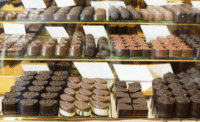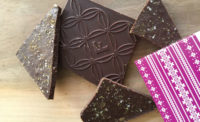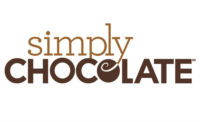Premium Chocolate
Now that the ‘chocolate bar’ has been raised towards more premium varieties, retailers need to strategize to capture an even higher-impulse chocolate market.
Premium Chocolate Estimated U.S. Retail Market Size
$1.5 - $1.8
billion
Source: Confectioner estimate based on input from
industry players
Overview
Premium chocolate is reaching for the Starbucks. Not
only have “chocolate bars” (a la Starbucks’ cafés)
started popping up in urban areas, but consumers everywhere are spending
more for — and are enjoying more — quality chocolate. And all
the major chocolate players are in on it — “everyday
premium” has become the confectionery catchphrase as mainstream
chocolate players join those on the higher end of the cocoa spectrum with
investments and marketing in more upscale chocolate.
The so-called “mass premium” chocolate
players, previously more exclusive, are recently making great distribution
strides in the mainstream market (approximately 40 percent of premium
chocolate sales now come from food/drug/mass channels, according to a
Mintel Premium Chocolate Report, released in February 2005).
According to industry data, premium chocolate is
growing in double digits, while all other chocolate is mostly flat.
Target Audience
Many consumers have a love affair with chocolate, but
one group in particular is leading the passion for premium: women ages 25
to 54, particularly those affluent, educated and urban. These females are
characterized by their busy lifestyle, combined with the desire to treat
themselves with “a bit of luxury.”
It’s true that these women want
“good” chocolate as a stress relief/treat, but with the vast
competition in the marketplace today, coupled with their seriously limited
free time, they are very impulsive about their premium purchasing decisions
— even more so than the mainstream market is with
“regular” chocolate. A premium chocolate maker recently found
that 68 percent of its consumers make the decision to purchase their
chocolate in-store, compared with 60 percent of consumers who made the
decision to purchase a non-premium brand in-store.
Pricing/Positioning
Premium chocolate prices come in all
“sizes.” With so many mainstream players now in the game,
prices are all over the board — varying from just over $8 a pound. As
for the “everyday premium” trend — the key price points
have been identified as $2.99 and $4.99.
The price of premium sets the category apart, but that
should not be the only segregating factor. For non-seasonal chocolate, the
in-line set for premium chocolate should be next to other confections, but
clearly delineated. With an expanding base of consumers that appreciate
high-end chocolate, retailers should encourage them to trade up.
Adjacencies
The floral/gift section is the first obvious choice,
but retailers shouldn’t stop there. While they may not seem
“premiere” enough at first, high traffic areas such as endcaps
and checkstands are great placement opportunities to capture the busy
consumer’s self-consumption needs.
Marketing/Promotion
Premium chocolate manufacturers are reportedly
expanding their shipper and quarter-pallet offerings to the mass market
— typically for “change-maker,” single-serve (one or two
bites) premium pieces with a popular promotional price point of 99 cents or
3 for $2.
Seasonal Opportunities
Premium chocolate sales traditionally have been very
seasonal, but consumers’ attitudes towards rewarding themselves with
higher-quality “everyday treats” are changing that. That being
said, seasonal chocolate does make up approximately 20 percent of
premium’s sales, according to industry research in the food, drug and
mass sectors, excluding Wal-Mart. There is a particularly strong seasonal
push in the first and fourth quarters to coincide with Valentine’s
Day and Christmas — the most popular holidays for premium chocolate.
Outlook
Industry experts say premium chocolate will continue
its trend of double-digit sales growth in the next five years, given the
recent explosion and near-future focus of new entrants and SKUs.
Established premium players are touting their continued significant
investment in their brands with updated packaging and line expansions;
mainstream players promise a premium presence with recent acquisitions and
newly created upscale lines; and European entrants are expanding their
distribution/focus in the United States.
To meet consumers’ demand for unique taste
experiences and their love of chocolate, premium chocolates are also
expected to develop more unusual and stronger flavors, adding to the
market’s awareness and consumer options.
More Power to Premium
Approximately 40 percent of premium chocolate
sales now come from food/drug/mass (FDM) channels
In FDM channels, premium chocolate purchases are
shifting from drugstores
The future will bring more mass chocolate
manufacturers into the premium chocolate market
Note: Premium chocolate in this report is defined as
chocolate candies with an upscale positioning and price tags exceeding 50
cents an ounce. This can be compared to the price of a regular Hershey
chocolate bar which retails for roughly 30 cents an ounce.
Source: Mintel Premium Chocolate Report — U.S.
— February 2005
Merchandising Musts
Make sure you have the floor. Floor displays
are a very effective method of promoting premium chocolates because many
premium brands are earlier in their life cycle and thus possess lower brand
awareness. Clearly displaying these products can drive incremental sales by
generating unplanned purchases from the highly impulsive target consumer.
Mix it up. Premium chocolate consumers are
more variety-seeking than mainstream chocolate consumers. Rotating new
products on counters and endcaps, as well as mixing up the plan-o-gram more
frequently, will stimulate more incremental purchases from these
spontaneous consumers.
Separate and define. Clearly segregating the
premium chocolate section in-line is imperative; this is your chance to
reinforce to the consumer that this chocolate is special and worth it.



